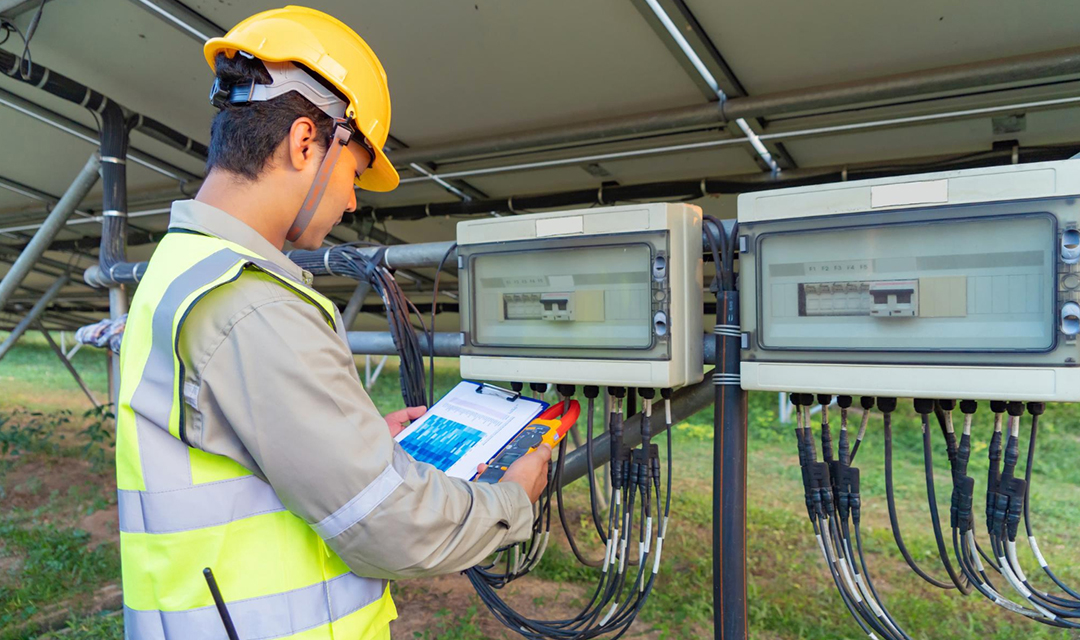
- May 19, 2025
- By admin
- Testing and Commissioning
A well-designed and properly installed earthing network is the foundation of effective protection systems. Without strict adherence to design standards, even the most advanced systems can fail. Power Engineering Services delivers comprehensive earth testing services – from expert design and precision commissioning by qualified technicians to ongoing monitoring—ensuring long-term performance and safety.
Why Earthing Matters
A high-performance earthing system safely dissipates electrical currents under normal and fault conditions, preventing operational disruptions, equipment damage, and, most critically, protecting personnel from electric shock.
Our Expertise
We specialise in critical earth testing services to maintain system stability and compliance. Our team uses cutting-edge equipment and advanced software to test and validate earthing systems at all voltage levels, ensuring they meet regulatory and safety standards, including:
- AS2067:2008, AS/NZS 3835.2:2006
- IEEE Std 80:2000, IEEE Std 81:2012
Comprehensive Earth Testing Services
We test for:
- Integrity or Continuity
- Soil Resistivity
- Step & Touch Electric Shock Injury
- Off-Frequency Current Injection & Distribution
- Fall of Potential
- Earth Potential Rise
End-to-End Support
From initial design to lifetime monitoring, we ensure your earthing system meets the highest standards. Proper installation and commissioning prevent failures, enhance reliability, and safeguard personnel.
Trust Power Engineering Services
With deep expertise and advanced diagnostics, we optimise safety and performance in electrical infrastructure. Our unwavering commitment to value drives every solution we provide.
Contact us today to enhance the safety and resilience of your earthing systems.
The Unsung Hero: Why Earth Testing Services are Crucial for Safety and Efficiency
In our technologically advanced world, the silent, unseen systems that ensure our safety and the smooth operation of our infrastructure are often the most critical. Among these unsung heroes is earth testing, a vital process that plays a pivotal role in electrical safety, construction, and a surprising array of other industries. While it might sound like something out of a geology textbook, understanding earth testing and the services that provide it is essential for anyone involved in building, maintaining, or managing electrical installations.
So, what exactly is earth testing? At its core, earth testing, also known as ground testing, measures the resistance of an earthing system. An earthing system provides a safe path for fault currents to dissipate into the ground, preventing electrical shocks, equipment damage, and potential fires. Think of it as a safety valve for electricity. A low-resistance path to earth is crucial for this system to function effectively. Earth testing services employ specialised equipment and techniques to verify that this path is indeed low enough to be safe and compliant with regulatory standards.
Why is this so important? Imagine a scenario where an electrical fault occurs in an appliance or a piece of industrial machinery. Without a properly functioning earthing system, the fault current could energise the metallic casing of the equipment. Anyone touching it could receive a dangerous, potentially fatal, electric shock. Furthermore, fault currents can cause overheating, leading to fires and extensive damage. Regular earth testing helps to identify and rectify potential problems before they escalate into hazardous situations, protecting lives, assets, and ensuring operational continuity.
There isn’t a one-size-fits-all approach to earth testing. Professionals in this field utilize various methods depending on the type of installation, soil conditions, and specific requirements. Some common techniques include:
- Fall of Potential Method (Three-Point or Four-Point Test): This is perhaps the most widely recognised and reliable method. It involves driving temporary test electrodes (stakes) into the ground at specific distances from the earth electrode being tested and measuring the resistance.
- Clamp-On Testing: A more convenient method for existing installations, this technique uses a specialised clamp meter to measure resistance without disconnecting the earthing system. While quicker, it may have limitations in certain scenarios.
- Soil Resistivity Testing: This test measures the resistivity of the soil itself. The results are crucial during the design phase of an earthing system, as soil composition significantly impacts its ability to conduct electricity. Different soil types (clay, sand, rock) have vastly different resistivity values.
- Continuity Testing: This ensures that all metallic parts of an installation that should be earthed are, in fact, properly connected to the main earthing terminal.
The applications of earth testing services are far-reaching. Construction projects, from residential homes to large commercial buildings and industrial plants, rely heavily on thorough earth testing to meet safety codes and ensure the longevity of electrical systems. Power generation and distribution companies conduct regular earth testing on substations, transmission towers, and distribution networks to maintain grid stability and prevent widespread outages. Telecommunication facilities, with their sensitive electronic equipment, require robust earthing to protect against lightning strikes and electrical surges. Even industries like mining and oil and gas depend on effective earthing to prevent ignition sources in potentially explosive atmospheres.
Choosing a reputable earth testing service provider is paramount. Look for companies with:
- Certified and Experienced Technicians: Ensure they have the necessary qualifications and a proven track record.
- Calibrated and Modern Equipment: Accurate testing relies on well-maintained and up-to-date instruments.
- Knowledge of Relevant Standards: They should be familiar with local and international safety regulations (e.g., IEC, IEEE standards).
- Comprehensive Reporting: Detailed reports that clearly explain the test results, any identified issues, and recommendations for remediation are essential.
In conclusion, while it may operate behind the scenes, earth testing is a fundamental aspect of electrical safety and operational integrity. By ensuring a low-resistance path to ground, these services protect us from electrical hazards, safeguard valuable equipment, and contribute to the reliable functioning of the infrastructure we depend on daily. Investing in professional earth testing is not just a regulatory requirement; it’s an investment in safety, peace of mind, and long-term operational efficiency. Don’t underestimate the power of the ground beneath your feet – and the experts who ensure it’s working for you.

